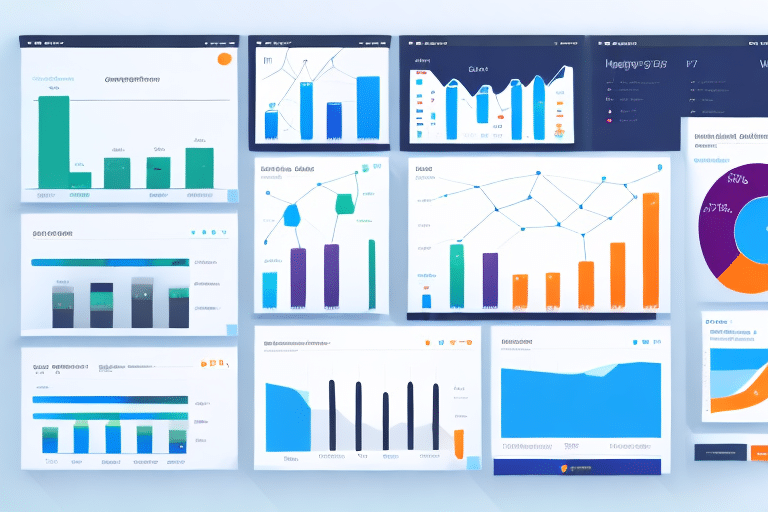Introduction to Traffic Sources in E-Commerce
E-commerce businesses thrive on traffic. Without visitors to their websites, they cannot generate revenue or grow their customer base. This is why measuring traffic sources is critical for the success of any e-commerce operation. In this article, we will explore the importance of tracking traffic sources and explain how to do it through Google Analytics. We will also delve into the various types of traffic sources and discuss their impact on e-commerce success.
Understanding the Importance of Traffic Sources for E-Commerce Operations
Knowing the sources of your website traffic is key to optimizing your e-commerce marketing strategy. By tracking the origin of your traffic, you can identify which channels are driving the most conversions and revenue for your business. This information allows you to allocate your resources more effectively and focus on the channels that generate the highest ROI. Additionally, measuring traffic sources can help you discover new opportunities for growth and improve your website's overall user experience.
Analyzing Visitor Behavior
One important aspect of tracking traffic sources is understanding the behavior of your visitors. By analyzing the pages they visit, the time they spend on your site, and the actions they take, you can gain insights into their interests and preferences. This information can be used to personalize your marketing messages and enhance the relevance of your website content, leading to higher engagement and conversion rates.
Identifying Potential Issues
Another benefit of tracking traffic sources is the ability to identify potential issues with your website or marketing campaigns. For example, if you notice a high bounce rate from a particular traffic source, it may indicate that your landing page is not optimized for that audience or that your ad targeting needs adjustment. Addressing these issues can improve the effectiveness of your marketing efforts and drive more revenue for your e-commerce business.
The Role of Traffic Sources in Driving Conversions and Revenue
The traffic sources that drive conversions and revenue for your e-commerce business will vary depending on your products or services. For instance, if you sell fashion items, you may find that social media channels such as Instagram or Pinterest have high conversion rates. Alternatively, if you provide specialized B2B services, you may discover that referral and direct traffic are your primary sources of revenue. Understanding which sources of traffic lead to conversions and revenue is critical for optimizing your digital marketing efforts.
Utilizing Analytics Tools
One way to determine which traffic sources are driving conversions and revenue is to use analytics tools such as Google Analytics. These tools provide valuable insights into the behavior of your website visitors, including where they are coming from, how long they are staying on your site, and which pages they are visiting. By analyzing this data, you can identify which traffic sources are most effective at driving conversions and revenue, and adjust your marketing strategy accordingly.
Different Types of Traffic Sources to Measure
There are four primary types of traffic sources:
- Direct: Visitors who come to your site by typing your URL into their browser or clicking on a bookmark.
- Referral: Traffic that comes from other websites linking back to your site.
- Organic: Visitors who find your site through search engines like Google and Bing.
- Paid: Traffic from advertising campaigns such as pay-per-click (PPC) or display advertising.
By measuring each type of traffic, you can gain valuable insights into which sources are driving revenue and conversions for your e-commerce business.
Direct Traffic
Direct traffic is often considered the most valuable type because it indicates that visitors are already familiar with your brand and are actively seeking out your website. This can lead to higher conversion rates since these visitors are typically more engaged and ready to purchase.
Referral Traffic
Referral traffic can also be valuable, as it indicates that other websites are endorsing your content and driving traffic to your site. However, it's important to monitor referral traffic closely to ensure that the referring sites are relevant and trustworthy.
Organic Traffic
Organic traffic is a crucial source for many e-commerce businesses, driving a significant amount of high-quality traffic to your site. However, ranking highly in search engine results pages (SERPs) can be challenging, especially for competitive keywords. Implementing effective SEO strategies is essential to improve your organic reach.
Paid Traffic
Paid traffic can be an effective way to supplement your organic traffic and drive targeted visitors to your site. Utilizing platforms like Google Ads allows you to target specific demographics and keywords. It's important to carefully monitor your paid campaigns to ensure a positive return on investment (ROI).
Setting Up Google Analytics to Track Traffic Sources
Google Analytics is a powerful tool that allows you to monitor traffic sources and other key performance indicators for your website. To set up tracking for traffic sources:
- Create a Google Analytics account.
- Add the tracking code to your website.
- Configure your goals and funnels to track conversions.
Once set up, Google Analytics will track all traffic to your site and provide comprehensive reports on the origin and behavior of your visitors. You can use this data to improve your marketing strategy and optimize your website's user experience.
Key Benefits of Google Analytics
- Identify which channels are driving the most traffic.
- Understand visitor engagement and behavior.
- Optimize marketing efforts based on data-driven insights.
Analyzing Direct Traffic: What It Is and Why It Matters
Direct traffic can be a valuable source of revenue for e-commerce businesses, but it can also be challenging to analyze. Since direct traffic can come from various sources, including bookmarks and untrackable mobile apps, determining its origin requires careful analysis. Monitoring direct traffic helps in discovering opportunities for improving customer retention and building a loyal following.
Segmenting Direct Traffic by Device Type
To better understand direct traffic, segment it by device type. Analyzing behavior differences between desktop and mobile visitors can reveal important insights. For example, you may find that mobile visitors are more likely to abandon their shopping carts, indicating a need to improve the mobile checkout process.
Understanding Visitor Intent
It's essential to understand the intent behind direct visits. Some visitors may come to your site directly because they are already familiar with your brand and are looking to make a purchase. Others may be new to your site and are exploring. Segmenting your direct traffic based on intent allows you to tailor your marketing efforts to better meet the needs of each group.
Decoding Referral Traffic: Identifying High-Quality Sources
Referral traffic comes from other websites that link back to your site. To identify high-quality referral sources, focus on sites with relevant content and high engagement levels. Use Google Analytics to track referral traffic and determine which sources generate the most conversions and revenue for your business.
Building Relationships with Top Referral Sources
Not all referral traffic is created equal. Some sources may send a lot of traffic that doesn’t convert, while others may send highly engaged visitors. Focus on building relationships with high-quality referral sources that drive valuable traffic. This can involve guest posting, partnerships, and collaborations with reputable websites in your industry.
Evaluating Referral Quality
Analyze the behavior of referred visitors to ensure they engage meaningfully with your site. Metrics such as time on site, pages per session, and conversion rates can help assess the quality of referral traffic.
Understanding Organic Traffic: The Importance of SEO
Organic traffic results from visitors finding your site through search engines like Google and Bing. SEO (search engine optimization) is critical for generating organic traffic and boosting your e-commerce success. By optimizing your website's content and structure for search engines, you can improve your visibility in search results and attract more targeted traffic to your website.
Key SEO Strategies for E-Commerce
- Keyword Optimization: Research and incorporate relevant keywords into your product descriptions, titles, and meta tags.
- Content Marketing: Create valuable content such as blog posts, how-to guides, and videos to attract and engage visitors.
- Technical SEO: Ensure your website has a fast load time, mobile-friendly design, and proper site architecture.
- Backlink Building: Acquire high-quality backlinks from reputable websites to improve your domain authority.
Implementing these strategies can significantly enhance your organic search performance and drive more qualified traffic to your e-commerce site.
The Power of Paid Traffic: Leveraging PPC Advertising
Paid traffic refers to visitors who come to your site through paid advertising campaigns such as pay-per-click (PPC) or display advertising. PPC advertising can be a powerful tool for generating targeted traffic and driving conversions for e-commerce businesses. Platforms like Google Ads allow you to target your ads to specific demographics and keywords, ensuring that your traffic is highly relevant to your business.
Maximizing ROI with Paid Advertising
To maximize your ROI from paid campaigns:
- Targeting: Use detailed targeting options to reach your ideal audience.
- Ad Copy: Craft compelling ad copy that encourages clicks and conversions.
- Landing Pages: Optimize landing pages to match ad intent and facilitate conversions.
- Performance Tracking: Continuously monitor and adjust your campaigns based on performance data.
By carefully managing your PPC campaigns, you can drive high-quality traffic that converts into customers, generating significant revenue for your e-commerce business.
Social Media Traffic: Essential for E-Commerce Growth
Social media platforms such as Instagram, Facebook, and Twitter are powerful sources of traffic for e-commerce businesses. Leveraging these platforms allows you to build brand awareness, engage with customers, and drive targeted traffic to your website.
Strategies for Effective Social Media Marketing
- Engaging Content: Create and share content that resonates with your audience, such as images, videos, and stories.
- Community Building: Foster a community by interacting with followers, responding to comments, and encouraging user-generated content.
- Influencer Partnerships: Collaborate with influencers to reach a broader and more engaged audience.
- Paid Social Ads: Utilize paid advertising options on social platforms to target specific demographics and interests.
By implementing these strategies, e-commerce businesses can generate significant traffic from social media, leading to increased sales and growth.
Measuring Email Marketing Traffic: Boosting Sales with Targeted Campaigns
Email marketing is a valuable tool for generating traffic and boosting sales for e-commerce businesses. By sending targeted email campaigns to your customer base, you can drive traffic to your website and encourage repeat purchases.
Optimizing Email Campaigns
- Personalization: Personalize emails based on customer behavior and preferences to increase engagement.
- Segmentation: Segment your email list to send relevant messages to different audience groups.
- Compelling Content: Provide valuable content, such as exclusive offers, product recommendations, and informative articles.
- Clear CTAs: Include clear calls-to-action that guide recipients to take the desired action.
By focusing on these strategies, e-commerce businesses can enhance their email marketing efforts, leading to improved customer retention and increased revenue.
Using Data to Optimize Your E-Commerce Marketing Strategy
Measuring and analyzing traffic sources provides e-commerce businesses with valuable insights into customer behavior and preferences. By leveraging this data, businesses can optimize their digital marketing efforts to improve customer retention and generate more revenue.
Data-Driven Decision Making
Use data from tools like Google Analytics to make informed decisions about your marketing strategies. Understand which channels are performing best and allocate your resources accordingly to maximize effectiveness.
Integrating Multiple Marketing Channels
Combine insights from various traffic sources to create a cohesive marketing strategy. For example, use data from SEO efforts to inform your content marketing and align paid advertising with your organic search strategies.
Conclusion
Measuring traffic sources is essential for the success of any e-commerce operation. By understanding which channels are driving revenue and conversions, e-commerce businesses can optimize their marketing strategies and drive growth. Whether through organic traffic, paid advertising, or email marketing, leveraging insights from traffic source data can help maximize your e-commerce success.




















